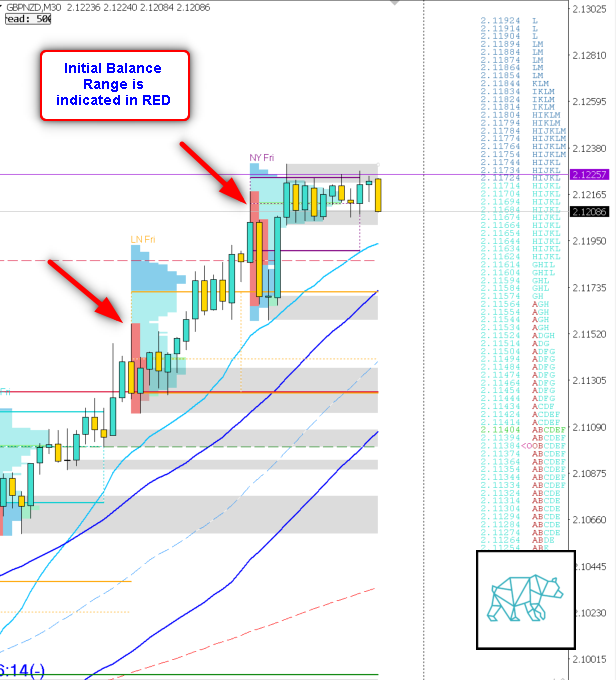
12 Aug Mastering the Art of Day Trading Strategies: How to use the Initial Balance Range for Day Trading
## Understanding the Initial Balance Range (IBR)
As a day trader, understanding the Initial Balance Range (IBR) is crucial for your success in the market. The Initial Balance refers to the first few minutes of trading when the market opens. It sets the tone for the rest of the trading day and provides valuable insights into market sentiment. By mastering the IBR, you can gain an edge and make informed trading decisions.
The IBR is the range between the highest and lowest prices traded during the initial period of the trading day. This range is significant because it represents the initial market consensus on price. Traders use the IBR to gauge whether the market is bullish or bearish and determine potential support and resistance levels.
The Importance of the Initial Balance in Day Trading
The Initial Balance is important in day trading because it provides a reference point for the rest of the trading day. It’s the time and range that Market Makers establish. They do this by fulfilling orders for larger institutional traders. This range helps traders identify key levels of support and resistance, which are crucial for making profitable trades. By understanding the IBR, you can anticipate potential breakouts or reversals and position yourself accordingly.
Additionally, the IBR can help you manage risk. By setting stop-loss orders below the IBR’s low or high, you can limit potential losses if the market goes against your position. This is particularly useful for day traders who want to protect their capital and maintain a disciplined approach to trading.
How to Calculate the Initial Balance Range
Calculating the Initial Balance Range is relatively straightforward. First, identify the opening range, which is the price range between the market’s open and the first hour of trading of any trading session. Then, determine the highest and lowest prices traded during this period. The difference between these two prices is the IBR.
For example, let’s say the market opens at $50 and reaches a high of $52 and a low of $48 during the initial period. The IBR would be $4 ($52 — $48). This range provides valuable information for day traders to base their trading decisions on.
Using the Initial Balance Range as a Trading Strategy
The Initial Balance Range can be used as a standalone trading strategy or in conjunction with other technical indicators. One common approach is to wait for a breakout above or below the IBR and enter a trade in the direction of the breakout. This is called a Sustained Auction setup where the strategy assumes that the market will continue in the direction of the breakout, providing an opportunity for profit. This works best in market conditions that favor an imbalance ie. trending markets.
Alternatively, some traders use the IBR to identify potential reversals ie. Failed Auctions. If the market fails to break out of the IBR and starts to reverse, it could indicate a shift in market sentiment. By entering a trade against the initial market direction, traders can capitalize on these reversals and profit from the market’s change in sentiment.
Common Abbreviations and Terms Related to the Initial Balance (IB)
As you delve deeper into day trading, you’ll come across various abbreviations and terms related to the Initial Balance (IB). Understanding these terms will help you communicate and navigate the trading world more effectively.
IB: Abbreviation for Initial Balance.
Opening Range: The price range between the market’s open and the first few minutes of trading.
IBR: Abbreviation for Initial Balance Range.
IBH: Initial Balance High (edge of IB)
IBL: Initial Balance Low (edge of IB)
SA: Sustained Auction
LSA: Late-Sustained Auction
FA: Failed Auction
AF: Auction Fade (following a SA)
Tips for Mastering the Initial Balance Range
Mastering the Initial Balance Range takes time and practice. Here are some tips to help you improve your trading skills:
- Study historical data: Analyze past market data to identify patterns and trends related to the IBR. This will help you make more accurate predictions and improve your trading decisions.
- Use multiple timeframes: Look at the IBR on different timeframes to get a comprehensive view of the market. This will help you identify trends and potential areas of support and resistance.
- Consider the imbalance in relation to Previous Day’s Value Area
- Combine the IBR with other indicators: The IBR is most effective when used in conjunction with other technical indicators. Experiment with different combinations to find what works best for you. If you would like to see what I use please click here.
- Manage risk: One way is to set stop-loss orders below the IBR’s low or high to limit potential losses. Another way is to use a stop loss size based on the Average Session Range. This is what I use. I’ll explain more in a future post. Stick to your risk management plan and avoid chasing trades that are outside your risk tolerance.

Tools and Indicators for Tracking the Initial Balance
To effectively track the Initial Balance, you can use various tools and indicators. Here are some popular options:
- Volume Profile: This indicator displays the volume traded at each price level during a specified time period, including the IBR. It helps traders identify areas of high and low volume, which can act as support and resistance levels.
- Market Profile: Similar to the Volume Profile, the Market Profile provides a graphical representation of the IBR and subsequent price levels. It helps traders visualize the distribution of trading activity and make informed trading decisions. This is what I use.
- Candlestick Charts: Candlestick charts provide valuable information about the price action during the IBR. Traders can analyze patterns and formations to identify potential trading opportunities.
Real-Life Examples of Successful Trades Using the Initial Balance Range
To illustrate the effectiveness of the Initial Balance Range as a trading strategy, let’s look at some real-life examples:
- Sustained Auction (SA): The market opens with a strong bullish sentiment, breaking out above the IBR’s high. Traders who entered long positions at the breakout point would have profited as the market continued to rally throughout the day.
- Failed Auction: The market fails to break out of the IBR and starts to reverse, indicating a shift in sentiment. Traders who entered short positions at the reversal point would have profited from the market’s downward movement.
These examples highlight the potential profitability of trading the Initial Balance Range. However, it’s important to note that no trading strategy is foolproof, and market conditions can change rapidly.
Resources for Learning More about the Initial Balance and Day Trading
If you’re interested in learning more about the Initial Balance and day trading, here are some valuable resources to check out:
- At risk of tooting my own horn but I’d say you’re already at the best resource right here at www.bearmarkettrader.com
- Books: “Market Profile” by James Dalton and “Mastering the Trade” by John F. Carter provide in-depth insights into day trading strategies, including the Initial Balance Range.
- Online Courses: Websites like Udemy and Investopedia offer online courses on day trading that cover various topics, including the Initial Balance and its significance. I recommend the beginner courses of Deeyana Angelo from the Market Stalkers.
- Forums and Communities: Joining trading forums and communities can provide a wealth of knowledge and opportunities to connect with experienced traders. Although in my experience you’ll have to dig through a lot of bad ones. Sadly this industry is full of people selling the dream instead of actually making money off trading. Websites like Reddit and TradingView have active communities where you can learn from others and share your experiences.
Conclusion
Mastering the Initial Balance Range is a valuable skill for day traders looking to enhance their trading performance. By understanding the IBR, calculating it accurately, and using it as a trading strategy, you can gain a competitive edge in the market. Remember to combine the IBR with other technical indicators, manage your risk effectively, and continuously educate yourself to improve your trading skills. Follow my blog to learn more about how to use the initial balance range and take your day trading to the next level.
Follow my blog to learn more about what strategy I use. Feel free to reach out and ask questions. I understand at first glance my trading strategy seems complex. But as with all good things, with time, you’ll understand how to “measure” and thus “read” the markets.





No Comments